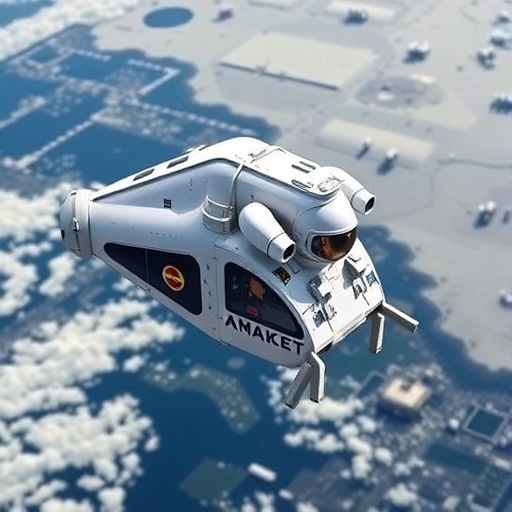In a groundbreaking study published in the Annals of Biomedical Engineering, researchers have investigated the critical issue of pulmonary contusion risks that astronauts may face during off-nominal Earth-return capsule landings. This research sheds light on the complex interplay of forces that astronauts experience upon re-entering the Earth’s atmosphere, which can result in potentially severe lung injuries. The findings of this study not only enhance our understanding of astronaut safety but also pave the way for advanced protective measures in space travel.
As space exploration continues to expand, the safety of astronauts remains a paramount concern. The study conducted by Ma et al. highlights that as astronauts re-enter the Earth’s atmosphere, the spacecraft experiences a rapid deceleration and significant blunt forces. These forces are especially concerning during mishap scenarios that could lead to off-nominal landings, which, in turn, may increase the risk of injuries, including pulmonary contusions. The authors emphasized that these injuries could have dire implications for astronauts’ health and overall mission success upon re-entering Earth after long-duration spaceflights.
One of the key factors in understanding pulmonary contusion risk is the biomechanical response of the human body to impact forces. The researchers used sophisticated simulation models to analyze how pressure waves generated during landing could affect the lungs. They found that the sudden increase in pressure could disturb lung tissues, leading to bruising and other forms of damage. These findings reinforce the need for developing more robust simulations when designing spacecraft and evaluating the forces astronauts experience during potential emergency landings.
The study utilized advanced computational fluid dynamics and finite element analysis to simulate the landing scenarios faced by astronauts. This intricate modeling allowed researchers to visualize how forces propagate through the body during a landing event. By examining the stress and strain on lung structures, the team gained valuable insight into which areas may be most vulnerable to injury. This approach not only provides answers about pulmonary contusions but also lays the groundwork for future investigations into other injury mechanisms associated with space travel.
Moreover, the authors addressed the critical importance of pre-existing conditions when evaluating risk factors for pulmonary contusions. Astronauts, who often face rigorous physical training and health screenings, may still harbor latent vulnerabilities that could exacerbate injury risks during off-nominal landings. This awareness calls for a personalized assessment framework that incorporates individual health histories in conjunction with the biomechanical data used in simulations.
Furthermore, the study opens up discussions regarding the design of next-generation astronaut protection gear. Traditional landing protocols have primarily focused on skeletal and musculoskeletal injuries. Still, the recognition of pulmonary contusions as a serious risk suggests that protective measures must evolve to include comprehensive safeguarding against internal injuries, especially to vital organs such as the lungs. Ensuring that astronaut suits are equipped with technologies that absorb impact in more efficient manners could mitigate the risks highlighted by this research.
The implications of this study extend beyond immediate astronaut safety. Insights gained from the research could inform medical protocols for treating lung injuries sustained during space travel. Understanding the mechanisms of pulmonary contusions allows astronauts and mission support teams to develop quicker and more effective response strategies to medical emergencies in space. These advancements could ultimately enhance survival rates and quality of health care in extraterrestrial environments.
As the field of aerospace medicine continues to evolve, the need for interdisciplinary collaboration becomes increasingly vital. Ma and colleagues encourage ongoing dialogue between engineers, clinicians, and military experts to develop a comprehensive approach to risk management of pulmonary contusions in space. Each discipline contributes unique perspectives that can lead to innovative solutions for astronaut safety, resilience, and overall well-being during missions.
The study adds to an expanding body of literature showcasing the significant challenges posed by re-entry and landing forces in aerospace medicine. The research community will undoubtedly benefit from continuous investigations into the biomechanical effects of these forces, both inside and outside the capsule environment. As new technologies emerge, the potential to create highly specialized landing protocols and protective equipment tailored to the unique needs of astronauts will become a reality.
In conclusion, the work by Ma et al. marks a pivotal stepping stone in recognizing and addressing the risks of pulmonary contusion among astronauts. Through advanced simulations and a comprehensive understanding of biomechanical forces, this study equips researchers, designers, and medical professionals with the knowledge necessary to enhance safety protocols for future space missions. As the push for human exploration of Mars and beyond intensifies, ensuring astronaut health and safety during every phase of space travel will remain a central focus for researchers and organizations worldwide.
This research is not just a study; it triggers a vital need to rethink how we secure the well-being of astronauts in off-nominal situations, heralding a future where space exploration is considerably safer and more sustainable. The interest generated by this study is likely to reach all corners of the scientific community and beyond, resonating with policymakers and investment firms interested in the future of human spaceflight.
Subject of Research: Assessment of pulmonary contusion risks in astronauts during off-nominal Earth-return landings.
Article Title: Pulmonary Contusion Risk Assessment in Astronauts During Off-Nominal Earth-Return Capsule Landings.
Article References:
Ma, X., Wang, D., Wang, Y. et al. Pulmonary Contusion Risk Assessment in Astronauts During Off-Nominal Earth-Return Capsule Landings.
Ann Biomed Eng (2025). https://doi.org/10.1007/s10439-025-03839-3
Image Credits: AI Generated
DOI:
Keywords: pulmonary contusion, astronaut safety, aerospace medicine, impact forces, simulation models.




